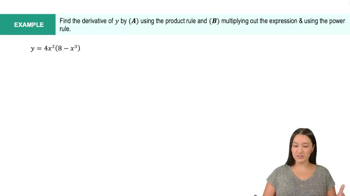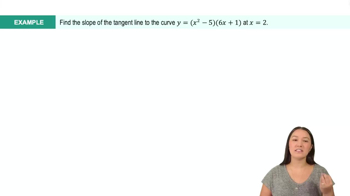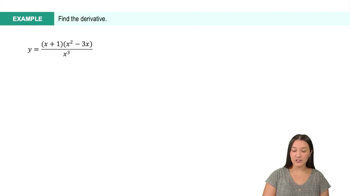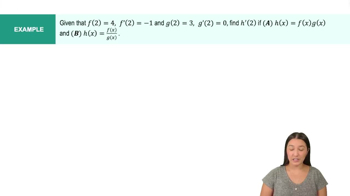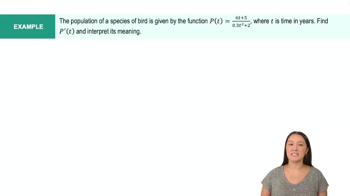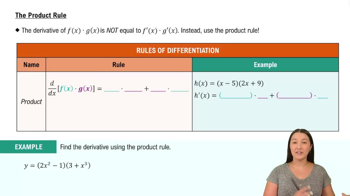Table of contents
- 0. Functions7h 52m
- Introduction to Functions16m
- Piecewise Functions10m
- Properties of Functions9m
- Common Functions1h 8m
- Transformations5m
- Combining Functions27m
- Exponent rules32m
- Exponential Functions28m
- Logarithmic Functions24m
- Properties of Logarithms34m
- Exponential & Logarithmic Equations35m
- Introduction to Trigonometric Functions38m
- Graphs of Trigonometric Functions44m
- Trigonometric Identities47m
- Inverse Trigonometric Functions48m
- 1. Limits and Continuity2h 2m
- 2. Intro to Derivatives1h 33m
- 3. Techniques of Differentiation3h 18m
- 4. Applications of Derivatives2h 38m
- 5. Graphical Applications of Derivatives6h 2m
- 6. Derivatives of Inverse, Exponential, & Logarithmic Functions2h 37m
- 7. Antiderivatives & Indefinite Integrals1h 26m
- 8. Definite Integrals4h 44m
- 9. Graphical Applications of Integrals2h 27m
- 10. Physics Applications of Integrals 2h 22m
3. Techniques of Differentiation
Product and Quotient Rules
Problem 3.21
Textbook Question
Find the derivatives of the functions in Exercises 1–42.
𝔂 = 1 x² csc 2
2 x
 Verified step by step guidance
Verified step by step guidance1
Step 1: Identify the function components. The given function is \( y = \frac{1}{x^2} \csc(2x) \). This is a product of two functions: \( u(x) = \frac{1}{x^2} \) and \( v(x) = \csc(2x) \).
Step 2: Apply the product rule for differentiation. The product rule states that if \( y = u(x) \cdot v(x) \), then \( y' = u'(x) \cdot v(x) + u(x) \cdot v'(x) \).
Step 3: Differentiate \( u(x) = \frac{1}{x^2} \). Use the power rule: \( u'(x) = -2x^{-3} \).
Step 4: Differentiate \( v(x) = \csc(2x) \). Use the chain rule: \( v'(x) = -2 \csc(2x) \cot(2x) \).
Step 5: Substitute \( u'(x) \), \( v(x) \), \( u(x) \), and \( v'(x) \) into the product rule formula to find \( y' \).
 Verified video answer for a similar problem:
Verified video answer for a similar problem:This video solution was recommended by our tutors as helpful for the problem above
Video duration:
4mPlay a video:
Was this helpful?
Key Concepts
Here are the essential concepts you must grasp in order to answer the question correctly.
Derivatives
The derivative of a function measures how the function's output value changes as its input value changes. It is a fundamental concept in calculus, representing the slope of the tangent line to the curve of the function at any given point. Derivatives can be computed using various rules, such as the power rule, product rule, and quotient rule, depending on the form of the function.
Recommended video:

Derivatives
Cosecant Function (csc)
The cosecant function, denoted as csc(x), is the reciprocal of the sine function, defined as csc(x) = 1/sin(x). It is important in calculus when dealing with trigonometric functions, especially when finding derivatives. Understanding how to differentiate csc(x) and its properties is essential for solving problems involving trigonometric derivatives.
Recommended video:
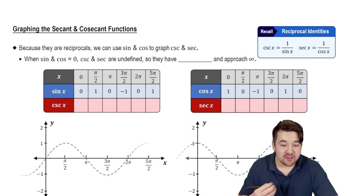
Graphs of Secant and Cosecant Functions
Quotient Rule
The quotient rule is a method for finding the derivative of a function that is the ratio of two other functions. If you have a function defined as f(x) = g(x)/h(x), the derivative is given by f'(x) = (g'(x)h(x) - g(x)h'(x)) / (h(x))². This rule is crucial when differentiating functions that involve division, such as the one presented in the question.
Recommended video:
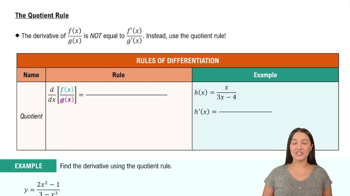
The Quotient Rule
Related Videos
Related Practice



